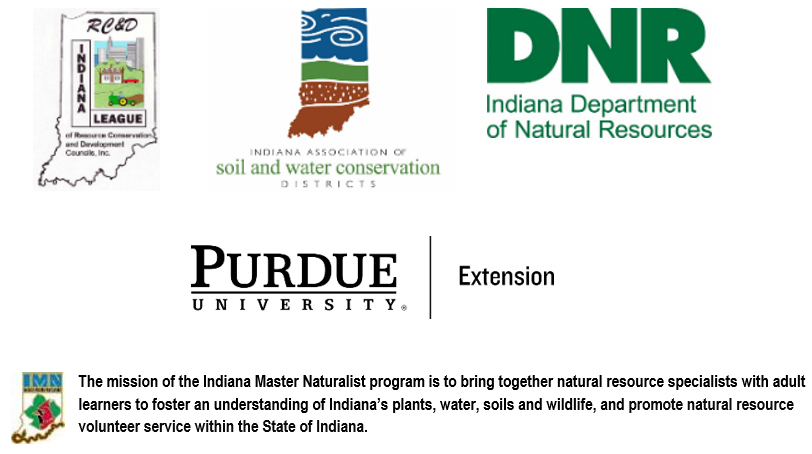IMNature
The Newsletter for IMN Hosts and Certified Graduates
2023 Spring Edition
 |
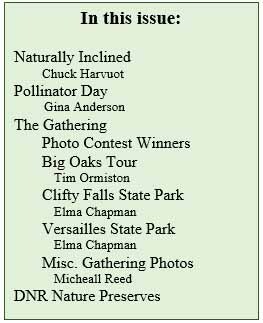
In early March I peered out my kitchen window and found I had a murder in my yard — a murder of crows. I saw eight to 10 of them on the snow-covered ground quickly eating seed. While I occasionally hear crows calling from the trees, I don’t ever remember seeing them around my feeder, but there they were.
I’ve learned it takes at least three crows to form a murder, but using that word to describe a group of crows seems rather unusual, at least to me. So, since it was an overcast, windy and cold day—and I didn’t really have anything else I needed to do—I went to my laptop to see if I could find out how that term came about. From my research, it’s a poetic term that started in England in the 15th century, resulting from folklore tales and superstition. Since crows are scavengers, will eat almost anything, and were often seen around battlefields and cemeteries, people began to associate them with tragedy and death. Being all black in color probably didn’t help, either. William Shakespeare, Edgar Allen Poe, Alfred Hitchcock, and even Walt Disney used crows to suggest a feeling of impending gloom.
|

While I was reading about crows, legends, and myths, I got diverted in a slightly different tangent in my research to an article that mentioned terms for other groups of birds: a host of sparrows, a charm of finches, a kettle of hawks, and a cast of falcons. Then it was on to a site that told me names for groups of other creatures. There were obvious ones like a colony of ants, a herd of deer, and a school of fish. There were also ones I didn’t know, but made a sort of sense: a stench of skunks, a prickle of porcupines, and a cloud of grasshoppers. Finally, there were terms I didn’t know existed, a cete of badgers, a knab of toads, and a nide of pheasant.
As I was going through the lists a thought came to mind, one that some might think diabolical, but one I thought might be fun. I’ve put together a short master naturalist “matching exercise” on the next page. Simply match the animal, bird, etc. listed in one column to the descriptive term in the other. One note. While going through the multitude of lists on the internet, I noticed that not all used the same terms for animals, and some used more than one. So, please keep in mind, this is meant to be fun and not a definitive list of correct terms.
|

Pollinator Day is Buzzing with Activity
By Gina Anderson

On April 29, Purdue Extension Floyd County and Sunnyside Master Gardeners will host Pollinator Day. This free, family-friendly event will be from 10 a.m. to 3 p.m. on the lawn of the Purdue Research Park of Southeast Indiana (3000 Technology Ave., New Albany, IN 47150), weather permitting. Classes being taught include Pollinator Way Stations, Pollinators and Climate Change, and Restoring Our Home Landscapes to Provide Habitat for Pollinators and Other Wildlife.
|

Other activities include booths on native bees, butterflies, pollinators and our food supply, hummingbirds, native plants, planting for pollinators, beeswax lip balm, a pollinator selfie booth, and much more. We also will be unveiling a new booth on pollinators’ relationships to popsicles, and a special activity for the whole family.
Please follow Purdue Extension Floyd County on Facebook and Instagram for more details about this event. If you have questions, please contact Gina Anderson, ANR Extension Educator-Floyd County, at 812-948-5470 or gmanders@purdue.edu.
|

Big Oaks National Wildlife Refuge Tour
Friday, March 31
by Tim Ormiston PE
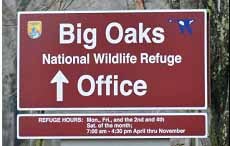
One of the pre-IMN Gathering options was to tour the Big Oaks National Wildlife Refuge. It is located about 8 miles north of Clifty Falls State Park and is managed by the U.S. Fish and Wildlife Service (USFWS). Our group of 40 was led by Joe Robb and his staff around the 50,000-acre property.
The refuge was formerly the Jefferson Proving Ground. It was used by the United States Army to test new weaponry in the early 1940s. After 50 years of testing, it was closed, allowing for repurposing the land as a refuge beginning in 2000. The refuge operates under a 99-year real estate permit from the Army.
|
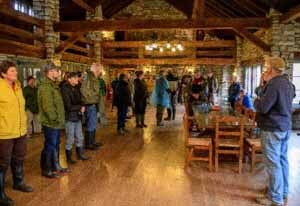
After a short introduction, refuge staff led the carpool caravan on a 15-mile journey north to the Old Timbers Lodge. A rainstorm was dropping its fury as we entered the refuge office, but it stopped by the time we started the caravan to the lodge, and the weather remained dry for the rest of the tour. The lodge was built in 1932 by Alexander Thompson for his personal use. Magnificent limestone blocks were used for floors, and walls and large solid wood timbers were used for framing. Unique hand-forged metal hinges were used for every window and door opening. The lodge property is restricted to special events managed by USFWS staff.
|

The next stop on the tour was a managed crawfish frog breeding site. Crawfish frogs are 2.5 to 4.5 inches long with a stubby body and a distinctive hump in their back. They have irregular dark spots with light boundaries. These frogs get their name from their use of crawfish burrows for shelter and feeding. The breeding site is controlled by a physical barrier around the pond. Five-gallon buckets are buried into the soil at regular intervals next to the barrier. The buckets are placed inside and outside of it. When any critter, large or small, runs into the barrier, they turn to the side and eventually end up in a bucket. The crawfish frogs can then be measured, and important data recorded. Unwanted animals that fall into this area are deterred from the breeding site. Other animals observed included pickerel frog, adult red spotted newt (Eastern newt), Southern leopard frog, and Jefferson salamander.
The final stop of the tour was a pond that had hosted frog and salamander egg masses. USFWS staff demonstrated how they measure a crawfish frog and then insert a tracking chip for future data collection.
Big Oaks National Wildlife Refuge is a restricted-use property, but various activities are available to the public. Please see fws.gov/refuge/big-oaks/about-us for more information.
|
Clifty Falls State Park - IMN Gathering March 30-April 1
By Elma Chapman
Another pre-IMN Gathering option was a tour of the historic Lanier Mansion and Jefferson County Historical Museum in Madison. Attendees learned about the rich history of the Madison area. |
|
 |

Friday night officially started the IMN Gathering with two programs. One was on live raptors from Hardy Lake and the other was a Jefferson County history program.
Saturday morning’s weather started out nice, but the cold front that swept through with high winds affected later activities. In the morning, participants rotated through three sessions. One was a visit to Clifty Falls State Park’s Nature Center. It was originally built by the Civilian Conservation Corps as a stable and had a wealth of displays and a fun children’s corner. There was also a program about ticks and the diseases they spread.
|
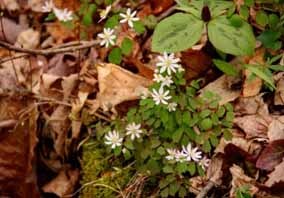
Thanks to Russ Vorhees for stepping in with this program when the herpetology presenter had to cancel the day before the event. Finally, there was a discussion of the new volunteer hour reporting process, which will be coming up for IMNs soon (right now it’s in the testing phase) and some information on the upcoming April 8, 2024 total solar eclipse. Campgrounds and hotels in the path of totality are already filled with reservations. It will definitely be an “all hands on deck” event, and IMNs may be asked to volunteer.
Next, we had a picnic lunch in the Clifty Shelter. It has a nice fireplace, and there was a blazing fire in it, so after each rotation of afternoon events, people were jostling for position near it. There were two hikes scheduled, but with the high winds, they had to be curtailed. A walk deep into the woods is not advisable when there are high wind warnings. We still did a wildflower walk and a waterfall walk in more open areas. I was surprised at the wildflowers that were already blooming. We saw bellflowers, violets, bloodroot, cutleaf toothwort, Virginia bluebells, trout lilies, spring beauty, and hepatica waving their blooms in the cold wind.
|

Another session in the afternoon was about invasive plants and insects. After the talk, participants were led out to the edge of the woods to identify the invasives. We planned to do a little removal work, but with the cold and wind, that too had to be modified.
|

If you’ve never been to Clifty Falls, put it on your to-do list. Located just west of Madison on the Ohio River, it has 1,519 acres and four major waterfalls. According to the park brochure, “Clifty Falls was created during the Ice Age when the southward flowing waters of Clifty Creek met the newly formed Ohio River in a spectacular plunge, a waterfall that may once have been 200 feet high. The falls has since cut its way into bedrock to a point more than two miles north of its original position. Today, at a height of 60 feet, it continues the retreat upstream at a rate of one-quarter inch per year.” Clifty Creek still rushes in the springtime, so to appreciate the falls at their fullest you need to visit between December and June. The park also has a lovely inn overlooking the Ohio River. It has been recently renovated.
The 10 trails in the park range from one-half mile to 4.5 miles in length. One is categorized as easy, one is moderate, and the others are marked moderately rugged, rugged, or very rugged. Hikers looking for a challenge will certainly find one here.
|
Versailles State Park - Post IMN Gathering trip
By Elma Chapman
The post-gathering option was a Sunday morning trip to Versailles State Park, Indiana’s second largest. The winds died down, and the sun came out, so it was a little more pleasant outside. There were two sessions, a tour of the nature center and a historic hike. The nature center will have a grand re-opening this year. Much renovation has been done, and new exhibits have been prepared with a lot of help from the Friends of Versailles State Park.
There was a live turtle display, aquarium wall, kids area, history room, bird viewing room, and butterfly garden. On the hike we learned about Indiana’s first federal park project, which later became the state park. It was built by the Civilian Conservation Corps from 1935 – 1937 as a federal recreation area of the National Park Service. Trees were planted, roads and paths were built, and native stone masonry and wood construction were used for the park’s features. In 1943, the NPS deeded the park to the state of Indiana, and it became a state park.
The creek was dammed to create a lake for recreation that opened in 1958. In 1987, swimming was prohibited in the lake because a new pool complex was built with a waterslide. While we were there, the pool was closed for the season, but a kettle of vultures was using the waterslide as a roost until the morning warmed up. The lake is still open to boating and fishing, and canoe and kayak rentals are available.
The downside of the park construction is that many old homesteads were taken and destroyed, so a lot of history was lost. If you know what to look for, you can still find traces of these homesteads in the park, or a knowledgeable naturalist can point them out during a guided hike.
Lunch was provided by the park’s Friends group: grilled hamburgers or hot dogs, macaroni salad, baked beans, chips, cookies and brownies, and a beverage. The roaring fire in the lodge where lunch was served was welcome. After lunch, Jody Heaston thanked everyone for coming, then led a few interested people to the Bradt Natural Area for a short tour.
Enjoy these pictures from the IMN Gathering
By Micheall Reed
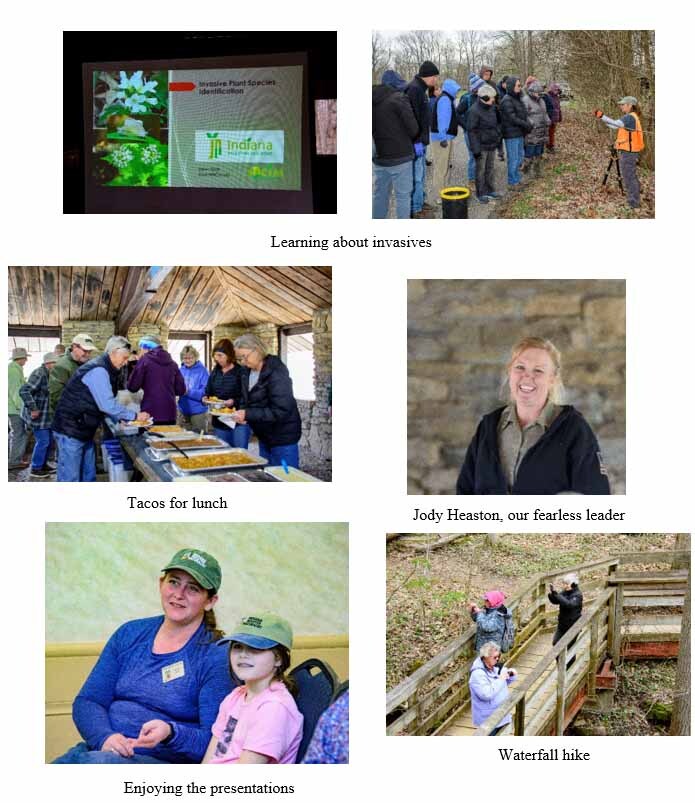 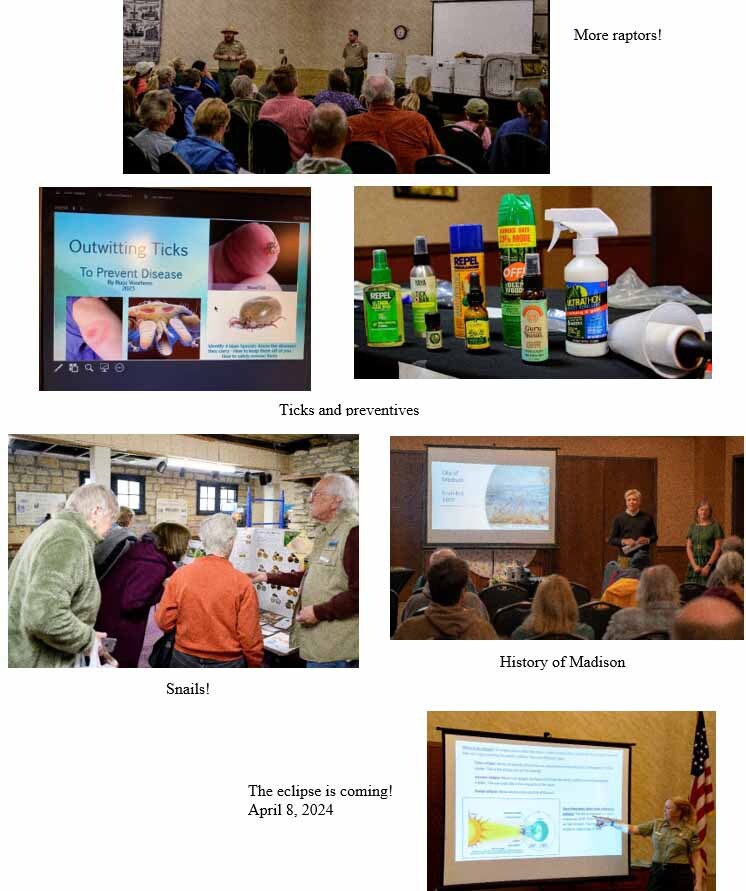 
From MyDNR, Indiana’s Outdoors News, April 2023
Join DNR Division of Nature Preserves for two free guided hikes
Moraine Nature Preserve, May 6, 9:30 a.m.
Moraine Nature Preserve contains a combination of rolling ridges, steep hills, pothole wetlands, and a shallow pond. The property protects a mosaic of natural communities including pond, shrub swamp, mesic upland forest, and dry-mesic upland forest.
Olin Lake Nature Preserve, May 20, 9:30 a.m.
At just over 100 acres, Olin Lake is the largest lake in Indiana with an undeveloped shoreline. Swamp forest along the shoreline includes tamarack, silver maple, red maple, and green ash. Skunk cabbage abounds in low, mucky spots. On the upland portion of the southeast shore is the remnant of a once-large woods. There are large specimens of sugar maple, beech, hackberry, and red oak trees.

|






